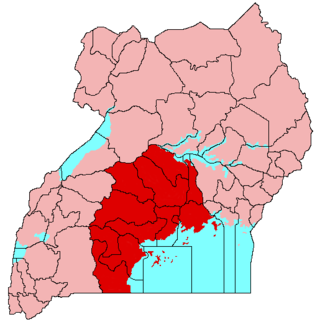
Buganda is a Bantu kingdom within Uganda. The kingdom of the Baganda people, Buganda is the largest of the traditional kingdoms in present-day East Africa, consisting of Uganda's Central Region, including the Ugandan capital Kampala. The 14 million Baganda make up the largest Ugandan region, representing approximately 16% of Uganda's population.
The early history of Uganda comprises the history of Uganda before the territory that is today Uganda was made into a British protectorate at the end of the 19th century. Prior to this, the region was divided between several closely related kingdoms.

Bunyoro, also called Bunyoro-Kitara, is a Bantu kingdom in Western Uganda. It was one of the most powerful kingdoms in Central and East Africa from the 13th century to the 19th century. It is ruled by the King (Omukama) of Bunyoro-Kitara. The current ruler is Solomon Iguru I, the 27th Omukama.

Nakasongola District is the northernmost district of the Central Region of Uganda. The town of Nakasongola is the site of the district's administrative headquarters.

Masindi District is a district in Western Uganda. Like many other Ugandan districts, it is named after its 'chief town' of Masindi, the location of the district headquarters.

Busoga is a kingdom and one of four constitutional monarchies in present-day Uganda. The kingdom is a cultural institution which promotes popular participation and unity among the people of the region through development programs to improve their standard of living.
The Jita are a Cushitic group based in Rorya District of Mara Region in northern Tanzania, on the southeastern shore of Lake Victoria. In 2005 the Jita population was estimated to number 205,000. The Jita have many clans such as the Rusori clan, Batimba clan, and Bagamba clan.
Luweero is a town in the Central Region of Uganda. It is the main municipal, administrative, and commercial center of Luweero District.
Articles related to Uganda include:

Buliisa District is a district in Western Uganda. As with most Ugandan districts, Buliisa District is named after its "main town" Buliisa, where the district headquarters are located. Bugungu has 6 sub counties: Kigwera, Ngwedo, Buliisa, Butiaba, Kihungya, and Biiso. It also contain 3 town councils: Buliisa, Butiaba and Biiso.

The Sezibwa River is a river in Central Uganda, in East Africa. The name is derived from the Luganda phrase "sizibwa kkubo", which translates into "my path cannot be blocked".

The Baganda also called Waganda, are a Bantu ethnic group native to Buganda, a subnational kingdom within Uganda. Traditionally composed of 52 clans, the Baganda are the largest people of the Bantu ethnic group in Uganda, comprising 16.5 percent of the population at the time of the 2014 census.

Kyankwanzi District is the westernmost district in the Buganda Region of Uganda and Buganda Kingdom, bordering Bunyoro. The district headquarters are in Butemba Town.
Buruuli (place) is a general term used to refer to the area where the Baruuli live. It is located in the district of Nakasongola, as well as in Bugerere Kayunga District. The Baruuli speak the Ruruuli language, a Bantu language closely related to Lunyala, a language spoken by the Banyala of Kayunga District. The Baruuli are ruled and governed by Ssabaluuli Mwogezi, who was crowned as their Kabaka by the president of Uganda Yoweri Kaguta Museveni.

River Kafu is a river in Uganda, in East Africa. On some older maps, the river is labelled as River Kabi.
Princess Jane Mpologoma Nabanakulya is a daughter of Uganda's first President Mutesa II of Buganda. She was born in Sunga Village, Buyaga County, Bunyoro-Kitara Kingdom, on April 12, 1964 by Omuzaana Naome Nanyonga, a midwife of Major General Sir Mutesa II of Buganda.

Banyala, are a Bantu ethnic group native to Buganda, a subnational kingdom within Uganda. They stay in an area called Bugerere in Kayunga District,. They share a common ancestry with the Baruuli.

The lost counties referendum of November 1964 was a local referendum held to decide whether the "lost counties" of Buyaga and Bugangaizi in Uganda should continue to be part of the Kingdom of Buganda, be transferred back to the Kingdom of Bunyoro, or be established as a separate district. The electorate, consisting of the residents of the two counties at the time of independence, voted overwhelmingly to be returned to Bunyoro.
Kagulu Hill, also Kagulu Rock, is a rocky prominence that rises 3,500 feet (1,067 m), above sea level, in the Eastern Region of Uganda.
The Hoima–Kinyara–Kafu High Voltage Power Line is a planned high voltage electricity power line, connecting the high voltage substation at Kabaale, Buseruka sub-county, Hoima District, in the Western Region of Uganda to another high voltage substation at Kafu, Nakasongola District, in the Central Region of Uganda. On the way, the power line passes through Kinyara Sugar Works, in Masindi District.











